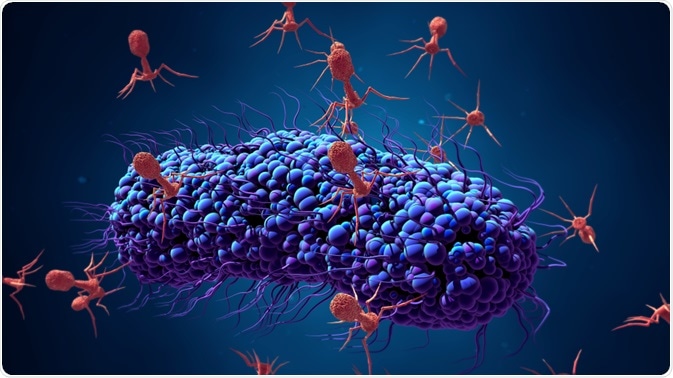Bacteriophages are a special type of virus that infect bacteria and have amazing structural and functional diversity. When a bacteriophage infects a bacterium, it can hijack the molecular machinery of the cell to make lots of progeny, and then burst, or lyse, the host cell to release the new virions – this is known as the lytic cycle.

Design_Cells | Shutterstock
What is a bacteriophage?
A bacteriophage is a form of virus which infects a bacterium and replicates within it. These bacterial parasites contain a head (nucleic acid enclose within a protein layer) and a tail (empty core enclosed within a sheath), which can be encoded in as few as four genes. There are many different types of bacteriophages, which infect many types of bacteria in different and diverse environments.
The wide variety of bacteriophage hosts has led to the suggestion that they could be used in phage therapy, mainly in situations where antibiotics are not successful. However, only virulent bacteriophages can be utilized, as temperate bacteriophages do not kill the host cell.
Virulent bacteriophages were initially defined in 1959 by Adams as “a phage that lacks the ability to lysogenize”. Phages can undergo two types of replication: lytic or lysogenic replication. Within a lysogenic cycle, the nucleic acid of the bacteriophage is integrated into the host’s genome, but the bacterium does not lyse.
However, in the lytic cycle, the cell is broken open following replication to release the new virions, thereby killing the host cell. As previously described by Adams, virulent bacteriophages are those which replicate through the lytic cycle.
What is the lytic cycle?
As previously mentioned, the lytic cycle is one of the two available life cycles for a bacteriophage. There are several different stages within the lytic cycle, as described below.
Initially, in a stage called adsorption, the bacteriophage attaches to the surface of the host bacterium cell. It does this by attaching via its tail to receptors upon the surface. For example, the T4 bacteriophage infects Escherichia coli, firstly attaching to the cell wall at the receptor sites.
Next, in a stage called penetration, the bacteriophage pierces the plasma cell membrane. For example, the T4 bacteriophage does this by degrading the cell wall with a specific enzyme. Once the wall is weakened, the genetic material is injected into the cell which leaves an empty capsid on the outside of the cell. This injected genetic material is occasionally circular in order to imitate that of the bacterium and prevent its detection by the immune system.
The next stage is transcription in which virion takes over the biological processes of the cell, instructing the transcriptional mechanisms to start generating phages and associated proteins, rather than the normal bacterial products. One of the earliest proteins which is formed leads to the degradation of the host DNA, maximizing in turn virion production.
Throughout the next biosynthesis or replication phase, the cell continues to make more and more prophage (approximately 200 in 25 minutes). This overall transcription/replication phase can also be divided into three different stages:
- Early replication phase: viral proteins prevent the formation of bacterial proteins.
- Middle replication phase: viral nucleic acid is transcribed.
- Late replication phase: head and tail are produced.
Next, during the maturation or assembly phase, the novel virions mature into adult viral phages, containing both heads and tails.
Finally, in the lytic phase, the cell wall is broken down by another viral enzyme. This means that the osmotic pressures become too extensive for the wall, which results in subsequent swelling and bursting of the cell. This ultimately releases all of the new, adult virions into the surroundings, where they can target other bacteria and continue to replicate.
Viruses (Updated)
Further Reading
Last Updated: Jan 22, 2019